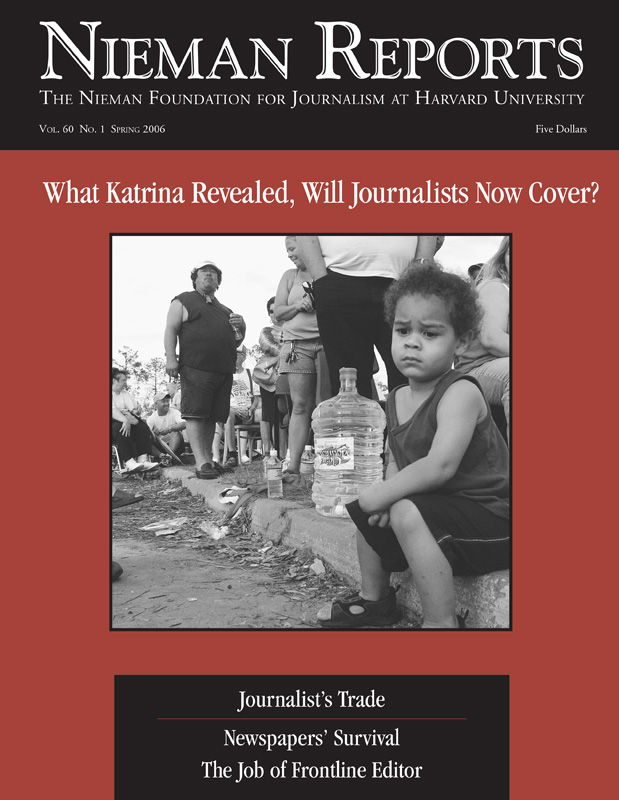Joanna Connors was an editor’s dream. The nationally respected film critic for The Plain Dealer in Cleveland, Ohio was a fast and fluid writer who rarely needed editing except for occasional lapses on length. She was always among the newspaper’s leader in byline counts. Then she met a story she couldn’t get out of her head.
Near the end of the 2004 Sundance Film Festival, she got a call from home. A young man who lived in the same upscale Cleveland suburb where she lived, who had gone to the same high school as her two teenage children, had just died of a heroin overdose. He was the son of two psychiatrists, a family that seemed to be living the American dream. She didn’t know the family, but the story touched her as a parent. "I was scared," she says.
She came to me, the paper’s writing coach and narrative specialist. She wanted to follow the family’s travails of dealing with the death of their son.
Just what I needed — another project. Writing coach was just one part of my job. I had 11 feature writers and columnists working directly for me with no assistant to fill in on editing. With Ohio figuring as one of the key states in the upcoming presidential election, I was about to embark on one of the largest election packages our paper had ever attempted. I directed a group of seven reporters, five photographers, and two graphic artists on a series called "The Five Ohios," that examined why our state was such an accurate barometer in presidential elections. I was also working with an intern who was going undercover to learn what it’s like to get by on a minimum wage job.
But enough whining; I consider myself a lazy editor: I rarely rewrite a reporter’s work. We chat, then I make them do the rewriting. Even on final edits, they sit at the keyboard and make all the changes while I watch. I edited 13 columns a week during most of 2004 — including the Pulitzer Prize-winning commentaries of Connie Schultz. I worked on 17 major projects (two open pages or more) and my staff produced almost 200 centerpieces for our daily section. But I rarely stayed at the office past six p.m., so I couldn’t say I was too busy to take on Joanna Connors. I had other misgivings.
My narrative mentor, Jon Franklin, taught me that if you are going to invest major time in one of these stories to make sure that it appears to be "clean" with some logical outcome. "I look for a clean story — with a limited number of elements," Franklin told me. "I want to make sure I know who the main characters are. I want a unified experience for the reader. … Above all, there are two things to avoid: Confusion and boredom. Readers get enough of both in their lives."
This story may not have been "clean" at the start — I had no idea where this story might lead, and there were lots of characters and conflicted elements — but I also knew it wasn’t going to be boring. I could tell that just from the passion I saw in Joanna as I listened to her recount the details. So I agreed to work with her. Besides, my boss told me to.
That was in March 2004. A year later, we still weren’t certain when this reporter-editor journey would end.
Finding the Story
Once Joanna decided to pursue the story, the next step was to earn access to the family. Sometimes, journalists make the mistake of reversing that process. We’re granted access to a heart transplant or get embedded with a military unit, so we decide we need to write a story about it.
Joanna spent hours getting to know Jim and Elaine Psarras, whose son Andy had died of the heroin overdose. She showed them previous narrative series the paper had written. She convinced them that their story might help others. Then she warned them: "This will be a long process. By the end of it, you will be sick of seeing me." But even she had no idea then how long it would be.
As we began to talk as reporter-editor, I talked to her about the transition to narrative journalism. "You’re not going to use direct quotes," I told her, looking for the surprise in her face. I saw none. "Dialogue replaces quotes." We talked about scenes, character development, filling her notebook with details. She bought Franklin’s book, "Writing for Story: Craft Secrets of Dramatic Nonfiction," and I gave her copies of other newspapers’ Pulitzer Prize-winning narrative series, including those done by Barry Siegel of the Los Angeles Times and The Oregonian’s Tom Hallman, Jr.
Now we had access, and we were speaking a common narrative language. But in any project like this there are bigger obstacles to overcome, questions that had to be answered, questions the Poynter Institute’s Chip Scanlan frequently challenges writers with: Whose story was it? What was it really about? What did it say about the world in which we live?
Franklin calls the process of finding these answers the search for "vision" — connecting the dots. At The Oregonian, narrative editor Jack Hart has his writers look for "meaning" or "the universal principle." Author-educator Walt Harrington, in an essay titled "The Writer’s Choice," talks about why storytelling must go beyond plot, character and scene. "Certainly it’s true that drama, intrigue and tension hold readers," he wrote. "That’s good in itself. But the elements of story are not only tricks but tools of inquiry, devices that direct our vision to the many nuances of real life."
So as Joanna and I met regularly, we kept talking about the questions. And the answers kept changing. With her movie background, Joanna began with the premise that she would recreate a true-life version of the film "Traffic," using Andy’s experiences to trace the heroin from Mexico to Shaker Heights as well as from scary street drug to suburban teen drug. But the authorities never found enough evidence in this case to arrest the local dealer, much less link the trail back to Mexico. Then we thought for awhile that the story might be about Andy’s best friend, Ben, who was using heroin with Andy the night he died. Ben could be resurrected by this experience. Except he wasn’t.
Then Joanna was certain she found the story. A bereaved family seeks justice. The parents and the local authorities decided to pursue murder charges against the suspected dealer because Andy’s death, they reasoned, had occurred as the result of a felony-selling heroin. We imagined a dramatic courtroom scene at the end, Jim and Elaine hugging as their son’s death is avenged.
The investigation continued for several months, with Joanna returning to the film beat most of the time, still keeping close contact with the Psarrases on nights and weekends. By now, she was almost part of the family. "When I talk to you, I feel like I’m in therapy," Elaine Psarras told her. Joanna frequently reminded her that she was recording their conversations, any of which could end up in the newspaper.
In the fall of 2004, the family — and our story — received a crushing blow. There would be no murder charges. The autopsy showed that besides heroin, Andy had been taking an antidepressant that had been suspected of causing suicidal behavior in teenagers. The drug hadn’t been prescribed by Andy’s doctor. It had been prescribed by his mother. There was no way, prosecutors said, to prove that the heroin by itself caused Andy’s death.
By now, I was getting questioned repeatedly by Joanna’s editors: When was this story going to end? I really couldn’t say. We agreed she’d return to criticism full-time through the 2005 Oscars. It seemed that the dream reporter’s story might turn into a nightmare. And I was mulling how to tell her that after all her work, it might be time to drop the story.
Then Joanna found her vision. It was crisp and clear. She made me see it, too.
Andy’s mother knew he used recreational drugs. But she didn’t know about the heroin. Certainly she never would have prescribed the antidepressant if she had. Finally, the parents began to acknowledge that they, too, had a role in their son’s death, instead of seeking to assign blame elsewhere.
What had scared Joanna as a parent when she first encountered this story — "If they’re both psychiatrists and they didn’t know, how are we supposed to?" — had now become her universal meaning: "How are we supposed to know about our kids’ secrets?"
Writing the Story
The writing process unfolded rather quickly. Joanna’s understanding of film techniques meant I didn’t have to beat the inverted pyramid out of her as I often do with first-time narrative writers. And though she was accustomed to having her work sail through her editors, she even embraced the process of multiple rewrites.
I usually took her drafts home at night, made a few notes on them, discussed them with her the next morning, and she would return to the computer. She also shared the stories with other writers, including her husband, and they made suggestions, too. So by the time the stories came back to me, there was very little polish to be done.
More importantly, she had done voluminous reporting, especially collecting police and court documents. In the exclusive neighborhood she was writing about, everybody has an attorney. And our attorney knew that.
RELATED WEB LINK
"Andy’s Last Secret"
– The Plain DealerJoanna was still following the family as late as May 8th. We began the seven-part series, "Andy’s Last Secret" on Sunday, May 22nd. The response from readers was so powerful that our editors asked for an eighth part on the following Sunday. Families who had been through the drug battle with a child or other loved one sent us their stories. Hundreds of others responded to Andy’s Foundation, which his parents set up to spread knowledge about drug use.
The story got real traction with our younger readers. Normally, the features section of our Web site averages 1,700 hits per day. During the eight days of "Andy’s Last Secret," that number was 25,000 per day — almost 200,000 through the series — and, even after it was out of the paper, the story still saw activity on the Web.
As for Joanna, I suppose some would say she’s no longer an editor’s dream. After her exposure to serious narrative journalism, she decided that she RELATED WEB LINK
"The Death of Producer Alan Schechter"
– The Plain Dealercouldn’t spend another summer reviewing movies like "Dodgeball." She is now the newspaper’s arts and entertainment critic, sort of the Frank Rich of the Midwest. But she’s spent the past couple of months working on another narrative — this one about the suicide of a local man who looked like he had it made as a Hollywood producer. Her byline count will never be the same.
Stuart Warner is writing coach and enterprise editor at The Plain Dealer in Cleveland, Ohio. He was the lead writer on the narrative "The Goodyear War," which was a centerpiece of the Akron Beacon Journal’s 1987 Pulitzer-winning coverage of the attempted takeover of Goodyear Tire & Rubber Company. He also supervised "A Question of Color," the Beacon Journal’s 1994 Pulitzer Gold Medal-winner.



